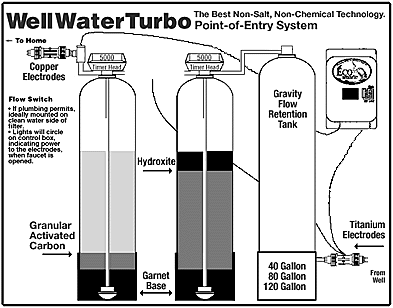How does the ECOsmarte system work?
How It Works
How does the ECOsmarte system work?
While the ECOsmarte system can treat city water, pond water, swimming pools and spas, the focus here is on well water for household use.
In this case, water is pumped from the well and enters the pressure tank.
- By-Pass: After the pressure tank, the water flows to the by-pass, which consists of three valves that direct the water in one of two directions. One is the option of running raw water from the well directly to the house; the other is to divert it through the ECOsmarte system which produces clean water to the house. A hose bib is installed by each filter valve, so both raw and filtered water can be sampled side-by-side.
- Titanium Chamber: Water first flows through a chamber containing two electrically charged titanium plates. These electrodes create pure oxygen. Oxidizing the water causes dissolved minerals to turn into solids. For example, ferrous iron becomes ferric iron. In a sense, the minerals and heavy metals are “rusted” and turn into larger clumps that can be filtered out; this process is called flocculation. Sulfur gas is turned into solid particles. The hardness, such as calcium and magnesium, is puffed up into a powder that will not stick or build up in the pipes, preventing scaling. Arsenic 3 is converted to Arsenic 5, enabling it to be filtered out.
- Contact Tank: This freshly oxidized water flows into what is called a retention tank or a contact tank to allow the water more time to contact the oxygen. The heavier oxidized particles settle at the bottom of this otherwise empty tank. Over time the sediment builds up, and once every year or two the tank should be drained to flush out the particles.
- Media Filter: The second tank contains a special media designed specifically to remove minerals and heavy metals and is particularly good for removing iron and manganese. The water must pass down through the media, then through gravel, then through a plastic strainer before it can flow up the center tube, called a riser, and then on to the next tank. During the night when no one is using the water the timer reverses the valve from service mode to back-wash mode; the frequency of days between backwash cycles is determined by the amount of contaminants in the water and the volume of use. During this cycle, the water passes down through the tube and blows up from the bottom of the tank, causing the media to rise and swirl around enough that the dirt that was gathered during the day can be blown out the drain hole. This flushing cycle lasts for ten minutes. The clock then turns the valve to rinse mode for another ten minutes; this cycle returns the water to flow down from the top of the tank to re-pack the filter bed so that the media is ready for another day of filtering.
- Granular Activated Carbon: The third tank contains granular activated carbon – GAC – which is famous for removing color, flavor, odor, and is excellent at removing chemicals such as chlorine, as well as pharmaceuticals and many other toxins. This tank backwashes less frequently, since the first tank filtered the majority of the heavy contaminants.
- Copper Chamber: The final stage is the chamber containing electrically charged copper plates to kill bacteria, virus, pathogens, and parasites risidually.
- By-Pass

